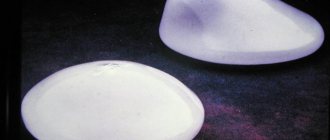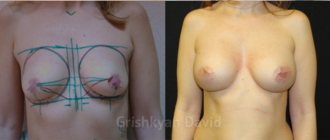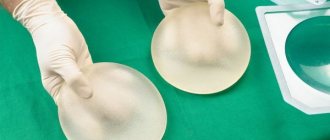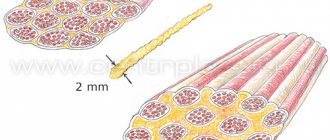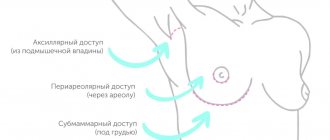Breast augmentation surgery is performed mainly for aesthetic reasons and is used to: - increase the volume and improve the shape of the breast:
— to restore breast volume after pregnancy or after major weight loss:
- for asymmetry of the mammary glands, congenital malformations, - endoprosthetics of the mammary glands is used as a method of correction after operations on the mammary glands, for example, after a mastectomy for cancer, or resections for benign neoplasms, previous inflammatory diseases (mastitis), - for correction shapes of the mammary glands with ptosis, both in isolated form and in combination with a lift:
Silicone implants (endoprostheses) are used for breast enlargement; currently this is the safest and most effective method without alternative. Implants are either round or teardrop-shaped. Their shell is made of chemically inactive, environmentally friendly material. The textured surface reduces the likelihood of fibrosis - hardening and compaction of the mammary glands. The gel inside gives natural softness and does not spread even if the outer shell of the implant is damaged.
Access or incision position for placing an implant during breast augmentation (Ryazan)
The access or incision position for placing an implant during breast augmentation is usually selected based on objective parameters and the wishes of the patient. The most commonly used: - inframammary:
- axillary; — periareolar approaches:
The transumbilical approach (through the umbilicus) is also used, but much less frequently than the others.
There are several options for the position of the implant: under the mammary gland, under the fascia, under the pectoralis major muscle, and in two planes: top under the muscle, bottom under the gland.
If the thickness of the integumentary tissue is less than 1 cm, the implant in all cases should be placed under the muscle.
Breast augmentation through inframammary approach (incision under the breast) The most widely used method of breast augmentation is a 3-4 centimeter incision in the crease under the breast. Through this incision, a wide pocket under the mammary gland or under the pectoral muscle is opened. An implant is placed in the formed pocket and the pocket is sutured. The advantage of this approach for breast augmentation is its simplicity, less pain and swelling in the postoperative period. The main disadvantage is the most non-cosmetic type of access: the scar in the long term (from 2 years) can form atrophic, stretchy, and migration of the scar is also characteristic.
Breast augmentation through the periareolar approach (incision along the areola) One of the most discreet incisions used for breast augmentation is made near the nipple, along the pigmented skin of the areola. Through this incision, a wide pocket under the mammary gland or under the pectoral muscle is opened. An implant is installed into the formed pocket and the pocket is sutured in layers. The advantage of this approach for breast augmentation is that the scar remaining after surgery is usually the least noticeable, and both a round implant and an anatomically shaped implant can be installed through it.
The disadvantage is that it is difficult to install if the areola is very small. Contrary to idle speculation, with this method the breast tissue is not dissected and the ductal system is not disrupted.
Breast augmentation through the axillary approach (armpit incision) The incision is made in the armpit in the area where axillary hair grows. This incision is then used to open a wide pocket either under the pectoral muscle or under the gland. Creating a pocket through an incision in the armpit is technically more difficult than with the inframammary and periareolar approaches, since it is difficult to reach the lower part of the breast from this position. It is also more difficult to examine the pocket to determine if there are small vessels that need to be cauterized or scar tissue that needs to be surgically removed. Therefore, in most cases, endoscopic equipment is used to form a pocket - special instruments with long handles and a video camera with a light. Using fiber optic instruments connected to a television screen, one can better see and operate inside the chest. An implant is placed in the formed pocket and the pocket is sutured. The advantage of the axillary approach is the absence of a visible scar on the breast itself, the disadvantages are technical complexity and the need to use special equipment (endovideo-resistant)
Preparation for breast augmentation surgery (mammoplasty) in Ryazan
An operation is a responsible step in the life of every person, a multi-stage and clearly not impulsive project to realize one’s own wishes. The first stage is choosing a doctor and receiving an initial qualified consultation. The age-old truth “every patient deserves his own doctor” is more than applicable in plastic surgery. If the unctuous “divorce” of another worthless star doctor “by advertisement” is more suitable for you than a specific and clear conversation with a highly qualified specialist, then this is worthy of a certain respect, but also regret. Take an interest in the category of doctor, which is easy to check at the Ministry of Health, and also go to the website of the Society of Plastic Surgeons of Russia. Didn't find a doctor? Think about why his work is not recognized by the professional community. As always, a critical part of preparing for breast augmentation surgery is being well informed and having realistic expectations about the outcome, possible risks, and postoperative circumstances. Great attention should be paid to describing the procedure for performing breast augmentation surgery and what the patient can expect after it. It is important for the doctor and the patient to reach an understanding regarding the degree of breast enlargement, shape, size, projection height of the future implant and its manufacturer. For example, a patient may come with a magazine photograph of the breast that she considers suitable for herself. It is also very important to reach mutual understanding in determining the access site (incision) for placing the implant and its position relative to the tissues of the gland itself and the pectoralis major muscle. There is no single standard for these important components of breast augmentation surgery; the choice depends on many factors: the size of the breast and nipple, the condition of the skin, the amount of gland tissue and many others. The second stage is a preoperative examination and clarification of the details of the upcoming operation. Firstly, the wider the range of examinations and specialists you undergo, the more all concomitant diseases that affect the outcome and safety will be identified. Secondly, all the questions that concern you need to be clarified in detail before the operation, so that there are no surprises after the operation.
How does this happen
If you have even the slightest thought about plastic surgery, do not put it off, but make an appointment with a specialist. Firstly, visiting a doctor does not oblige you to immediately undergo surgery. And secondly, this way you will receive detailed advice specifically regarding yourself.
At the initial appointment, the doctor will conduct an examination, prescribe the necessary examinations to prepare for the operation, and check for contraindications. At the same time, the cost of breast surgery in Ryazan is calculated, taking into account all the features of the procedure.
The operation itself usually takes no more than two to three hours. Since general anesthesia is used, you do not have to worry about any pain or discomfort.
After the lift, special rehabilitation will be required, which the doctor will discuss during your appointment.
Examination plan before mammoplasty
— Complete blood count — Blood group, Rh factor — Blood test for sugar — Biochemical blood test: — total protein, bilirubin — general, etc., inc. - ASAT, AlAT, rest. nitrogen, creatinine, urea - Na+, K+ - amylase, alkaline phosphatase - Coagulogram - Blood test for RW and ELISA, markers of viral hepatitis - General urine test - ECG (electrocardiogram with interpretation) - X-ray or FLG of the chest organs - Examination by a therapist (conclusion about the absence of contraindications to surgical treatment) - ultrasound of the mammary glands.
Mastopexy, or breast lift, is a surgical procedure aimed at restoring normal breast height and improving its contours. Breast lift is indicated in cases where the volume of the mammary glands is sufficient, but the breasts are drooping. Drooping of the breast is the result of the impact of its weight, loss of skin elasticity, as well as changes during pregnancy, with significant weight loss and due to a number of age-related reasons. The choice of surgery depends on the degree of ptosis, and in some cases on the subjective worldview of the patient. How can plastic surgery help today?
With grade 1 ptosis (), as well as with pseudoptosis (), the lifting effect can be achieved by breast augmentation with silicone implants. From the point of view of reducing the number of postoperative scars, this is the optimal solution. For those who do not want to enlarge their breasts, circular (or as it is also called periareolar) mastopexy is possible. After removing excess skin, scars will remain only around the areolas, the diameter of which, if there is excess, can be reduced to the desired size. With grade 2 ptosis (), the situation can be solved in two ways: endoprosthetics in combination with a periareolar lift or, if you do not enlarge the breast with implants, it is possible to perform mastopexy with a vertical suture (in this case, the incisions are located around the nipple and vertically to the inframammary fold). With grade 3 ptosis (), it is not possible to perform a lift as in the previous two options. But if breast augmentation is not required, then to create a better shape, a technique is used in which a scar in the fold under the breast will need to be added to the vertical scar (
). What effect do implants help create? They create the desired volume of the breast, increase the height of the breast realistically and steadily over time, which is achieved by applying special purse-string and other sutures much more difficult and riskier.
Preoperative examination plan. — Complete blood count — Blood group, Rh factor — Blood test for sugar — Biochemical blood test: — Total protein, bilirubin – general, etc., inc. - ASAT, AlAT, rest. nitrogen, creatinine, urea - Na+, K+ - Amylase, alkaline phosphatase - Coagulogram - Blood test for RW and ELISA, markers of viral hepatitis - General urine test - ECG (electrocardiogram with interpretation) - X-ray or FLG org. chest - Examination by a therapist (conclusion on the absence of contraindications to surgical treatment) - Ultrasound of the mammary glands
Postoperative period. After the anesthesia wears off, the surgical area will be tender and painful for several days. Most patients manage with mild analgesics and usually go home the next day. Antibacterial therapy is recommended for all patients and is carried out for 5-7 days. There are bruises and swelling in the operated areas, and there is pain and pulling only with certain movements. You should not raise your arms high above your head, as this causes unnecessary tension in the seams. Patients are advised to wear supportive compression garments around the clock for at least three weeks. Exercise and physical activity should be avoided for three weeks after a breast lift and then gradually resumed. However, any physical activity that strains and stretches the scars before they have stabilized can make them wider. It takes at least three months for the scar tissue to reach its full strength.
Risks and complications. In addition to the usual types of surgical risks - bleeding, inflammation, etc., complications specific to breast lift are associated with the amount of tissue removed. During breast lift surgery, only the skin is removed, so the risk of complications during the healing period is quite low. Breast lift surgery usually does not affect your ability to breastfeed. After breast lift surgery, breast sensation is temporarily reduced around the nipples and sometimes over a larger area. This happens because when excess skin is removed, some branches of the tactile nerves leading to the nipple are cut. Sensitivity usually returns within a month or two after a breast lift, and most patients experience complete recovery within six months. A few patients have areas of decreased sensitivity in different parts of the breast after a breast lift, but this rarely bothers them. Most women have slightly asymmetrical breasts even before breast lift surgery. Planning, measuring and marking your breasts before breast lift surgery are critical steps in achieving the most symmetrical, natural-looking result. However, it should be remembered that physiological asymmetry always occurs, and after surgery this feature remains. The appearance of scars after a breast lift undergoes natural changes and sooner or later, for the majority, they turn pale and merge with the surrounding skin. However, the patient should be aware that scars after a breast lift around and under the nipples will remain forever and in rare cases, the formation of hypertrophic, stretch marks and keloid scars is possible.
Before breast augmentation surgery in Ryazan
It is better to plan the operation in the first week of the monthly cycle, as the mammary gland is subject to cyclic changes. Before breast augmentation surgery, a woman must undergo an ultrasound or mammography, undergo tests, undergo all necessary examinations and talk with an anesthesiologist. Breast augmentation surgery is always stressful, so the patient should rest well before the operation. It is also advisable to take vitamins before breast augmentation surgery and eat well, eating enough meat, fruits and vegetables.
At least two weeks before breast augmentation surgery, smokers are advised to quit smoking altogether. Before undergoing breast augmentation surgery, it is important for the patient to inform their doctor about all medications they are taking. In the preoperative period, it is often necessary to stop taking medications that reduce blood clotting. These include acetylsalicylic acid (aspirin), a standard ingredient in painkillers. You should avoid taking these medications 14 days before and for a week after breast augmentation surgery. The evening or morning before breast augmentation surgery, the patient should thoroughly wash his body and hair.
On the day of breast augmentation surgery, it is advisable to avoid the use of cosmetics and lotions, and it is also necessary to remove nail polish, as it may interfere with breathing control during surgery, which is often done using sensors placed on the fingers. Since breast augmentation surgery is usually performed under anesthesia, it is important for the patient that there is no food or liquid in the stomach; for this purpose, you should absolutely not eat or drink on the day of the operation.
Upon admission to the clinic on the day of surgery, the patient is photographed, after which the surgeon applies preoperative markings with a marker. After premedication, the patient is taken to the operating room.
When is the operation performed?
There are several indications for plastic surgery:
- age-related decrease in skin tone;
- asymmetry of the mammary glands, low position, downward displacement of the nipple and areola, other individual structural features;
- drooping breasts after breastfeeding;
- stretch marks formed for various reasons;
- change in the shape and height of the breast due to sudden weight loss;
- discrepancy between the volume of the mammary glands and the skin surrounding them.
The reason for surgical intervention may also be the patient’s desire to correct the shape of the breast (in the absence of contraindications).
Breast augmentation surgery (Ryazan)
The third period is the operation itself, the early postoperative period and the rehabilitation period. The duration of the rehabilitation period is determined by the type and volume of the operation (the larger the operation, the longer the recovery process), the individual characteristics of the body (for example, the tendency of tissues to edema, prolonged resorption of bruises, etc.), as well as the type of anesthesia, the qualifications of the doctor, carried out by the rehabilitation complex.
After breast augmentation , in the early postoperative period, especially in the first few hours after surgery, the patient may experience quite intense pain, which is usually relieved with painkillers. Also, after breast augmentation, the patient usually notes that at first the breasts are very sensitive to touch. Movement is also a little painful. The day after breast augmentation, the pain has largely subsided, the patient is bandaged, the drains are removed and usually sent home, where she also takes painkillers if necessary. A week after breast augmentation surgery, the pain usually disappears, although the breasts are still sensitive to touch. Some patients experience pain when moving their arms or touching their breasts for several weeks, which is not abnormal. Immediately after surgery, your breasts may feel numb and swollen, but this feeling will become less and less as the weeks go by. Sutures are removed on the 7th day of the postoperative period. You can usually wash no earlier than 5-7 days after surgery, in the shower, protecting the suture line from water and detergents.
During the period after breast augmentation surgery, the patient's physical activity is limited, and in this regard it is recommended to wear light, comfortable clothes and shoes. Immediately after breast augmentation surgery, special compression garments must be used as a support bandage. This underwear must be worn around the clock for 3-4 weeks, taking it off briefly to wash. It is advisable to select and try it on in advance. Sports activities can be resumed with caution no earlier than a month after breast augmentation surgery, and then gradually increase the load without causing discomfort. It is not recommended to engage in sports that load the shoulder girdle, such as tennis, for 3 months. Always be in constant contact with the surgeon who operated on you. You should not find out questions that interest and concern you on the Internet or from “informed” individuals. This often leads to clearly ambiguous situations.
Breast lift
Breast lift (mastopexy) using plastic surgery methods allows you to restore the harmonious proportions of the mammary glands, correct asymmetry and correct the consequences of sagging of the bust caused by natural age-related changes in the skin and subcutaneous structures. Also, sagging breasts can occur due to sudden weight loss . Breast lift surgery will help restore your breasts to their beautiful, natural shape. Breast lifting after childbirth is quite popular : during pregnancy, breast volume increases, and after the end of breastfeeding, it loses its contours and becomes less firm.
Mastopexy can achieve better results in women with small breasts, and the effect of the operation lasts for quite a long time. This is due to the fact that there is no need for significant correction of overstretched tissues. Breast lift surgery can be performed in conjunction with other surgical procedures (for example, breast augmentation or reduction). After a breast lift, a woman will be able to breastfeed her baby in the future. But, if you are planning to become a mother soon, you are advised to postpone breast lift surgery. The reason for this is the natural changes that occur in the mammary glands during pregnancy. Having a mastopexy during this period may well worsen the result of the operation. At the same time, it should be noted that breast lift will not affect the course of pregnancy and childbirth. After a breast lift, the result lasts for more than 10 years, provided that you do not have weight fluctuations, either increasing or decreasing your weight by more than 5 kg. Pregnancy and childbirth also affect the results of a breast lift. This process will be much slower if the mammary glands are small, so a lift is often performed in combination with surgical breast reduction. Mastopexy techniques
Periareolar breast lift. The technique is used for minor prolapse of the mammary glands. An incision is made around the areola, the breast tissue is carefully redistributed, the nipple is moved to a new position, and the size of the areola is slightly reduced. As an advantage of this method, it can be noted that the scar after the operation is almost invisible.
Vertical scar lift .
The technique is used for significant breast ptosis, in combination with other operations. This method of tightening is by far the most popular. A skin incision is made around the areola and vertically down towards the crease under the breast. In the process of breast lift, the overstretched skin flap is removed, breast contours are formed, and the areola is moved to a new aesthetic position. At the end of the operation, a cosmetic suture is applied. After the operation, the scar around the areola is almost invisible, the vertical scar remains visible. Anchor. The scar is shaped like an anchor and goes around the areola, down to the crease under the gland and in both directions along the crease.
Preparing for surgery
An initial consultation is necessary before any plastic surgery, and a breast lift is no exception. During the consultation, the surgeon identifies indications and contraindications for mastopexy and informs about the most important stages of the operation. Before the operation, the patient is sent for examination. Also, at the stage of preparation for surgery, a woman is recommended to normalize her weight, stop smoking and use certain medications. During the consultation, the surgeon will inform the patient about the optimal volume of the upcoming operation. Preparation for surgery proceeds in the same way as for breast augmentation surgery.
Operation
Mastopexy is performed under general anesthesia. The operation time is about 1.5-2 hours. Almost always, a breast lift is accompanied by lifting the gland tissue, nipple-areolar complex (NAC) upward and fixing the breast in a new position using various methods and techniques. In general, the breast lift technique is similar to reduction mammoplasty, but, unlike the latter, breast tissue is not removed during the lift, but is redistributed - sometimes this even gives the visual effect of increasing breast size. It is imperative to stay in the hospital for a day after the operation.
After operation
The recovery period after a breast lift takes about a week. You will need to spend 1-2 days in a hospital (if general anesthesia is used), after which it is advisable to reduce your activity to a minimum for a few more days. The stitches are removed within 10-14 days. It is mandatory to wear compression garments for 2-3 weeks after surgery. In addition, in the next month, under no circumstances should you lift weights or play sports. During the rehabilitation period, pain and swelling are possible, which will gradually subside. A small percentage of patients also experience a permanent decrease or, conversely, an increase in nipple sensitivity. The final result after mastopexy can be assessed no earlier than after 3-4 months, when the scars have completely healed, turning into barely noticeable white stripes.
Before After Before After Before After Before After Before After
View price
